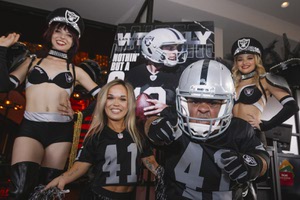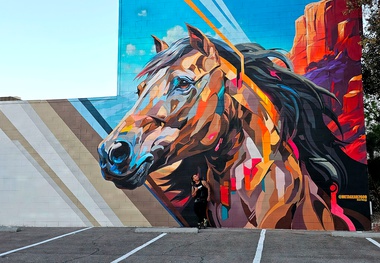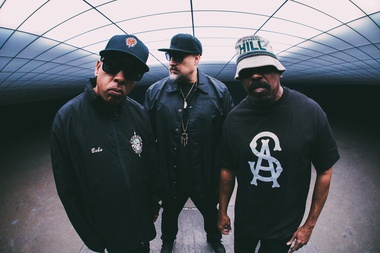Our booth is curved and cushy, positioned just to the left of steps descending to the stage. Make that stages: three runways that jut toward those seated at the circular tables below. In the middle of the scene is an old, black typewriter, illuminated by the beam of a spotlight shining from the venue’s upper reaches.
Behind that vintage Underwood Standard No. 5 typewriter is a set of drums and a pair of keyboards, and higher still, a series of fancy video panels, glowing brightly with the scripted word “Baz.”
This is a production show, mostly, a rock musical interlocking the relationships of couples in three movies (Moulin Rouge, Romeo + Juliet and The Great Gatsby) from the director and writer Baz Luhrmann, who has happily endorsed the effort. The experience of Baz is multifold: The production often feels like a concert for the smoking band onstage, and is set up much like a traditional musical—lavish costumes, vocal talent and expert dancing. But this experience exceeds even that unique model, because of the “where” of it all. These joyous ingredients are mixed in the blender of a nightclub on the Las Vegas Strip, Light at Mandalay Bay.
The club is open for business at this oddly early hour, just short of 8 p.m. In our seating area, drinks are set on a sturdy, rectangular table with a metal base built for bottle service during the club’s peak hours, when strobes flash and EDM thunders through the venue, long after Baz has left the stage.
*****
Seated at our booth is a couple who are not typical nightclub crawlers, a 50-something Las Vegas limo driver and his wife, given tickets by the hotel to help pollinate positive Baz buzz in the Las Vegas community. Cabbies, craps dealers, concierges, valet attendants have been enlisted as ambassadors—am-Baz-addors, as it were—for this grassroots marketing effort. We scope the room for the best sightlines and crane to look over the top of a metal railing that partially intercepts our view of what we’re about to see. Out of nowhere, a gentleman in a white bow tie and a cherry-red, ringleader-fashioned jacket scrambles to our area and calls out, “Good evening! If you like, sit at the top of your booths! You’ll have a better view!”
Before we can thank him he darts away, and in moments that same uniformed individual—the actor Jason Paige, who portrays Zidler—is onstage, dancing and singing “A Little Party Never Killed Nobody,” from The Great Gatsby. There’s laughter from our table, and someone notes that if Paige ever decides to leave the stage, he’d be a terrific singing usher. We take his advice, and move to our perch at the top of the booth.
*****
Setting up at Light in time for a June 26 premiere, Baz is the result of a fledgling relationship as unlikely as that shared by Christian and Satine in Moulin Rouge. The show’s artistic and business partners are Cirque du Soleil’s powerful and duly financed theatrical division, and the LA production company For the Record (the show’s formal title is For the Record: Baz, but Baz has since become the show’s shorthand name). Thus, the Strip show is a mix of the mighty Cirque brand and an upstart performance-art troupe that, three years ago, was staging Baz in clubs with audience capacities far less than 100.
The company launched five years ago with a tribute to Quentin Tarantino. It has since taken on John Hughes (Dear John Hughes) and then developed Baz. The latter debuted at a club called Show at Barre in LA, its original 60-seat venue. As audiences blossomed, the theater space was expanded to 150 seats and renamed Rockwell: Table & Stage. The company further expanded to shows featuring the Coen brothers, P.T. Anderson and Martin Scorsese, the Marshalls (Garry and Penny) and Robert Zemeckis. For the Record further grew to the DBA nightclub in West Hollywood in March 2014, where, in rotation, it presented Baz, Tarantino and Dear John Hughes.
It didn’t take long for a night with For the Record to become one of the groovier hangs among the Hollywood elite, with such celebs as Tarantino, Al Pacino, Barbra Streisand, James Brolin and the Marshalls making repeat visits. For the Record founder, co-creator and executive producer Shane Scheel tells a story of taking a call from someone he thought was Barbra Streisand, walking up the sidewalk to the show at DBA. It turned out it was the actual Barbra Streisand, with Brolin pacing at her side.
“We’re a company that has never worked in traditional theatrical spaces, so everything about us seems a little unique.” Scheel says. “We’ve been in supper clubs, nightclubs, a hotel multipurpose room in Palm Springs. Every time we move up, we learn just a little bit more about how to make our environment work for us.”
The company’s path to Vegas was not a direct route from LA, though. It detoured through the Montreal Jazz Festival last summer, where Scott Zeiger, who had months earlier moved from his post as co-CEO of BASE Entertainment to a new position as head of Cirque’s theatrical division, caught the company’s performance of Tarantino. He loved what he saw, but was concerned over the production’s violent adaptation of such films as Pulp Fiction, Django Unchained and Kill Bill.
Still, Zeiger was wowed by the talent, the polished production and For the Record’s ability to adapt to non-traditional performance settings. A theater executive who is always seeking innovative stage concepts (and who also brought Phantom—The Las Vegas Spectacular and Jersey Boys to the Strip), Zeiger was expressly interested in infusing some early-night animation into Light, which opened in 1999 as the club/restaurant Rumjungle and was taken over by Cirque du Soleil in the summer of 2013. Light remains a business partnership between Cirque (which owns the space) and Hakkasan Group (contracted to operate the venue). The club is open late nights, typically at 11 p.m. on Wednesdays, Fridays and Saturdays. Baz is a way to kick off the night rather than be the center of the Vegas experience. The show has been ratcheted from two-and-a-half hours in LA to a tighter hour and 40 minutes in Vegas. Baz actually opened for previews at Light with a five-minute intermission; by the end of that intermission, Zeiger had already made the decision to lop that segment from the show.
“For avid theater-goers, an hour and 40 minutes would be among the shortest-ever Broadway musicals,” Zeiger says. “That’s the length of A Chorus Line, and that musical is the most successful intermission-less musical ever.” But for Las Vegas, particularly for a show in a nightclub, that length still feels a little long.
“There is a checklist that people have for their Las Vegas experience, for their 72 hours in town. Shopping, gambling, the pool, a massage, the gym, dinner, a show, a club, the fountains at Bellagio,” Zeiger says. “Everybody has their list. Once you have somebody sitting in a theater a minute longer than an hour and a half, they start looking at their watch, no matter how good the show is. That’s the difference in Las Vegas, whereas in LA, it is the evening.”
The show’s length is being adjusted naturally over repeated performances, as is the calibration of sound in a relatively cavernous, 32,000-square-foot venue. The show is also figuring out how to keep the audience’s attention focused on the artists as they roam around the room.
In one of the few moments reminiscent of a Cirque show, Ginifer King, who plays Satine, floats through the venue on a lift to a point above the stage while singing “Smells Like Teen Spirit.” Principal singers Paige, James Byous (Romeo), Ciaran McCarthy (Jay Gatsby), Payson Lewis (Christian), Ruby Lewis (Daisy) and Olivia Harris (Juliet) routinely roam and explore the perimeter of the performance space.
Often, a voice emanates from the outer reaches, and those in the audience instinctively turn to find the origin of that sound. “We have had some straining-the-neck to find the action, which we are doing our best to mitigate,” Scheel says. “You’re in a nightclub, so you might feel like you’re overhearing or seeing things that you’re not supposed to, and that is a good thing. It gives the show a very voyeuristic idea, and that is very intentional. What we’re working in is really a giant black-box theater.”
It’s a theater that seats upward of 500 ticket-buyers, more than double any venue where For the Record has performed. Consequently, the show’s business prospects are less certain than its terrific presentation.
*****
Zeiger says it himself: “It’s funny, not that many people in the world know who Baz Luhrmann is. Less than you think. They know his movies, of course, but the name ‘Baz’ does not always resonate.”
That disconnect is further reflected in the confusion created by the current kingpins of Las Vegas entertainment, the superstar club DJs who headline at the ultra-club fortresses along the Strip. “I was asked, ‘Is Baz a DJ?’” Scheel says with a chuckle. “Baz at Light doesn’t sound so different from Tiësto at Hakkasan. What we’re really understanding is that the next frontier is to get our message out in a very concise way.”
Such an effort has been an attainable goal for Cirque du Soleil, which has thrown obscure names on many of its shows—O, KÀ, Mystère, Zarkana—but Baz is not a traditional Cirque vehicle.
The show’s relatively obscure title, coupled with the idea that it’s a production whose value must be seen to fully appreciate, makes it a tough sell on the Strip. In his days with BASE, Ziegler helped bring another successful show that shares those qualities, Absinthe, to Caesars Palace, in partnership with Spiegelworld and its founder, Ross Mollison.
“It’s sort of like Absinthe in the early days, when I worked on that show. It was all, ‘What’s Absinthe?’ Cirque du Soleil Light?” Zeiger says. “So, those first 12 weeks with Absinthe, we lost a fortune. But you have to expect that when you are bringing in unbranded entertainment without a star, in a landscape filled with brands and celebrities. It takes some time to build.”
Thus, the question is not whether Baz is yet making money. It isn’t. The more relevant questions are, will it make money? And how long will it take for the show to turn a profit?
“We have budgeted a contingency for this show to cover preview losses-slash-branding, and that’s where we are right now,” Zeiger says. “You always have to budget that contingency. Check any Broadway show, or any theater piece anywhere, and that is the case. We are branding the show, and our hook is that we’ve got super high-caliber entertainment onstage. We need to put that word out there and allow that message to resonate in the market.”
The big Cirque shows have that single-word brand—Cirque—to trumpet. Other large-scale productions benefit from high-financed marketing campaigns (Steve Wynn’s ShowStoppers) and simple titles that need no explanation (Frank: The Man. The Music).
But Zeiger exudes confidence. “Is Baz hitting its numbers? It’s hitting our expected numbers. Is it making profit yet? Not yet. But it will.”
The man who ultimately authorized the performance of Baz at Mandalay Bay is that hotel’s president and COO, Chuck Bowling. He says one goal has already been met.
“We wanted to break something unique, and have people walk away saying they’ve never seen anything like it before in Las Vegas, or anywhere in the country, or anywhere in the world,” he says. “When you think of what you can experience in this space, that is happening, and that has to happen. It’s a marketing challenge, and that effort will take some time. But it’s building, and we knew it would be a slow build.”
*****
The overarching concern, outside the continuing marketing effort, is if the so-called “immersive” live-entertainment approach can at all work in Vegas. Absinthe remains an outlier, a show whose unique in-the-round venue (the Spiegeltent) enhances the audience experience, rather than adding to the challenge. But the Strip’s history has been strewn with highly advanced, imaginative shows—many of them critically successful—that never turned a profit.
Dating back more than a decade, the Rio pitched its own tent for a show called De La Guarda, an acrobatic-based production with a water feature that actually drizzled on audience members. That show, in which audience members stood in an open space, lasted from October 2000 to July 2001. Nightspots that have featured atmospheric entertainment, especially at Ivan Kane’s Forty Deuce and its successor at Mandalay Bay, 1923 Bourbon & Burlesque, have either closed (in Kane’s instance) or struggled to stay afloat (in the case of 1923, with its operators still in litigation with onetime partner Holly Madison).
More recently, Vegas Nocturne at the Cosmopolitan’s Rose. Rabbit. Lie. was an artistic success that failed financially inside an atypical venue. The show, which featured an inspired series of specialty acts and a live band that morphed into a late-night club scene, was uniformly applauded and highly acclaimed by reviewers, but closed within seven months, in July 2014. Vegas Nocturne was seeping a reported $1 million per month and serving as the focal point of since-settled lawsuits between Spiegelworld and the Cosmopolitan.
Still, with its 40-something cast members and multiple stages (including one that rotated), Vegas Nocturne remains an example of what can be presented in a uniquely designed Vegas entertainment space. “We discussed vigorously with our partners how we could make the show successful,” Mollison says. “We had a specific timeline, and we had a very, very challenging timeline to operate under.” Which, Mollison contends, was too short to make a success of Vegas Nocturne at Rose. Rabbit. Lie.
But if Baz takes off, Mollison says, it could create a tangible trend of like shows in clubs along the Strip. “I feel there’s a whole market of people who would like to go out and get something that’s a more casual form of entertainment that can happen before they go to a nightclub, before dinner or even before they go to bed. You just need a show like that to be a hit, and I do hope Baz is successful, because the more shows that are successful, the better it will be for everyone.”
Even on the north end of the Strip, eyes are on Light and Baz and how the show performs at Mandalay Bay. SLS Las Vegas is attempting to reinvent Life, the megaclub that opened as a haven for superstar DJs and exclusive EDM programming but is now open to just about any variety of entertainment. When asked about Baz and the effort to reinvent nightclub spaces for production shows, SLS President and COO Scott Kreeger says, “It’s all moving in that direction, absolutely.”
*****
Longtime Vegas entertainment figures who well remember the much-hyped, ill-fated, “Broadway to Vegas” era of the mid-2000s remain unconvinced that the type of stage talent evident in Baz will ever be a first choice among Vegas tourists. Top-notch, Broadway-styled productions like Avenue Q, Hairspray, The Producers, Monty Python’s Spamalot and Phantom had runs of varying lengths, but none are onstage today.
“What they are doing is something innovative, something new,” says SPI Entertainment founder Adam Steck, whose productions include Boyz 2 Men at the Mirage, Human Nature at Venetian and Frank Marino’s Divas Las Vegas. “I just don’t think that particular type of entertainment, being very thespian-esque, has much life in Las Vegas, unfortunately. I wish it did. I just think Las Vegas is not as theater-sophisticated as other cities, because people who come here are looking for a different type of experience.
“Do I hope it works? Absolutely. The way they use the space, the breaking of the fourth wall and bringing people into the crowd in a non-traditional space—I’m all for it.”
The cast members have been spotted at shows around town, creating something of a stir when arriving at Rose. Rabbit. Lie., with talk swirling that Baz is already seeking another venue. Not so. For the Record and Cirque are in an open-ended agreement, and Scheel says, “We’re not looking at moving out of Light.” He calls the space “a jungle-gym of a playground,” and muses that the advanced video and sound technology could even be boosted by the acrobatic gadgetry of Cirque. Members of the troupe, too, have checked out shows ranging from the classic Jubilee! at Bally’s to Alice—A Steampunk Rock Opera Fantasy at Vinyl at the Hard Rock Hotel. That show could greatly benefit if Baz becomes a hit, as it is looking for both a home and someone to roll the dice, as Cirque is doing with Baz.
“What we’re finding in getting out and meeting the performance community is that there is a demand for something vocally and musically driven,” Scheel says. “We’re still in the learning curve of how the venue, Light itself, works, and how we present a show in this environment.
“But what we’ve loved doing is making the Baz show feel epic, in the sense that Baz’s movies are epic.”
All Baz needs is some time and some persuasive word of mouth. The ringleader Zidler and his lovelorn friends will handle the rest.
For the Record: Baz Nights vary, 8 p.m., $61-$83. Light, 702-632-4760.














